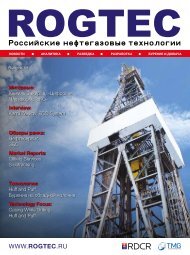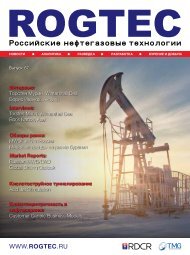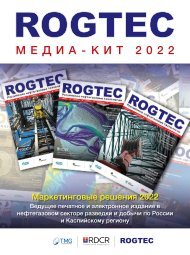ROGTEC Magazine Issue 61
Russian Oli & Gas Magazine
Russian Oli & Gas Magazine
You also want an ePaper? Increase the reach of your titles
YUMPU automatically turns print PDFs into web optimized ePapers that Google loves.
SMART WELLS
Проведение гидродинамикогеофизического
мониторинга при
разработке низкопроницаемых
коллекторов в России и за рубежом
До настоящего времени в России не было
оперативной, надежной, дешевой универсальной
цифровой технологии эффективного контроля
эксплуатации и мониторинга добывающих нефтяных
скважин. Особые трудности в этом направлении
возникли в последние годы, когда нефтяные
компании перешли на массовое применение
бурения горизонтальных скважин (ГС), проведение
объемных многостадийных гидроразрывов пласта
(МГРП), разработку низкопроницаемых коллекторов
с трудноизвлекаемыми запасами (ТРИЗ),
составляющих в настоящее время большую часть
запасов углеводородного сырья.
Фактически не существует подобных универсальных
технологий и за рубежом, так как стоимость
разработанных там высокотехнологичных систем
стационарного удаленного геомониторинга
настолько высока, что они используются
только в единичных скважинах на шельфовых
месторождениях, разрабатываемых с морских
платформ.
В России каждая добывающая нефтяная
компания пытается решать задачу повышения
эффективности гидродинамико-геофизического
контроля разработки и мониторинга добычи с
привлечением различных технических средств, как
правило, опираясь на общеизвестные методики
интерпретации и анализа, не предназначенные
для глубинных дистанционных информационноизмерительных
систем (ИИС) и не адаптированные
под новые задачи. Кроме того, отсутствуют
соответствующие федеральные руководящие
документы.
Для дочерних структур «Газпром нефти»,
на объектах которых доля ТРИЗ постоянно
растет, интеллектуальное заканчивание
высокотехнологичных скважин, а также удаленная
цифровая непрерывная диагностика забойных
параметров могли бы быть дать положительный
эффект. Чтобы реализовать данный потенциал,
необходимо:
• найти способы снижения расходов на
обустройство скважин глубинными стационарными
информационно-измерительными системами
(СИИС);
• определить подходы к извлечению из
избыточных, на первый взгляд, цифровых данных
дистанционного перманентного геомониторинга
Technologies for hydrodynamic and
geophysical monitoring of tight reservoirs
in Russia and abroad
A prompt, robust, cheap, and flexible digital technology
for the efficient control over the development and
monitoring of oil production wells has not existed
in Russia until recent times. This problem became
particularly challenging in recent years due to the
increased development by oil producers of horizontal
wells multi-stage fracturing and development of tight
reservoirs with unconventional reserves.
In fact, neither has similar universal technologies that
have been developed abroad – the cost of existing hitech
systems for permanent remote geo-monitoring is so
high that they are only implemented at selected offshore
wells that are being developed from platforms.
In Russia each oil producing company strives to increase
the monitoring efficiency of development and production
of their hydrodynamical and geophysical wells using
various means of technology. As a rule, they employ
generally known approaches to data interpretation and
analysis that are not suitable for subsurface remote
information and measurement systems (IMS) as neither
have been customized for this application. Besides the
corresponding state regulatory documents haven’t been
issued.
Subsidiaries of Gazprom Neft that face an increasing
share of unconventional reserves in their portfolios could
benefit from an intelligent completion system in hi-tech
wells and permanent remote digital monitoring of the
bottom-hole area. In order to realize this potential, it’s
required to:
• Find a way to reduce the costs of equipping wells with
permanent subsurface information and measurement
systems.
• Define approaches to extract robust quantitative
data sets which are required to perform historical
matching of the hydrodynamic models for the wellformation
system out of seemingly redundant datasets
of permanent remote geo-monitoring.
Compliance with conditions specified above is essential
to maximize the economic benefits of digitalization and
optimization development, through the operational
management of the well life cycle. However, the goal of
equipping production wells with systems for permanent
hydrodynamic and geophysical monitoring is not limited to
digitalization efficiency and well diagnostics.
A crucial technological target is to reduce production
losses associated with the need for long downtimes in
productions that are required for carrying out geophysical
www.rogtecmagazine.com
ROGTEC
51















